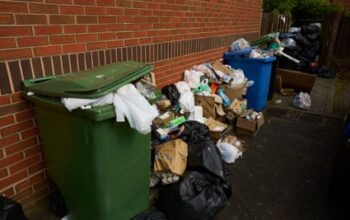New government data published on Monday showed that 95% of non-recycled waste in Essex is sent to landfill, as ministers launched their plans for a circular economy.
The data revealed that seven local authorities in England reported sending more than 40% of their residual waste to landfill in 2022 to 2023, with Essex county council at the top of the list.
Next came Cambridgeshire county council, (87% of waste sent to landfill), Southend borough council (74%), Darlington borough council (61%), Lancashire county council (59%), Leicester city council (57%) and Newcastle upon Tyne city council (56%).
At present, non-recyclable waste is either incinerated for energy or sent to landfill.
But as the population grows, the way packaging is used and made needs to change in order to reduce the amount of waste sent to landfill. This includes making it more recyclable and using less of it.
Ministers have announced a suite of plans to encourage a circular economy, including simpler recycling in England, so that less waste is sent to landfill or incinerated.
Other plans include a deposit returns scheme for plastic bottles, and charging manufacturers for producing too much waste using a “polluter pays” principle. This would incentivise producers to sell products in recycled and recyclable packaging.

In July, government targets were set which would require local authorities to send, on average, no more than 10% of municipal waste to landfill by 2035.
On Monday, as part of the circular economy strategy, a plan was announced to crack down on new incinerators and incentivise recycling instead. Almost half of all waste (49%) collected by local authorities in 2022-23 was incinerated, with just 40% recycled.
But the plans come against a backdrop of falling recycling rates, according to the latest data. In 2021, the household recycling rate was 44.1%, falling to 43.4% in 2022.
The new strategy will make it harder to get planning permission for incinerators. In order to build them, developers will have to demonstrate that their projects help lower the amount of non-recyclable waste sent to landfill or enable the replacement of older, less efficient plants.
Developers will also need to ensure new projects are built carbon-capture ready, once the requirements come into force, and show how they will make use of the heat they produce, which could be used to decarbonise other sectors. Incineration facilities provide about 3% of the UK’s energy generation.
The circular economy minister, Mary Creagh, said: “For far too long, the nation has seen its recycling rates stagnate and has relied on burning household waste, rather than supporting communities to keep resources in use for longer.
“That ends today, with clear conditions for new energy from waste plants – they must be efficient and support net zero and our economic growth mission, before they can get the backing needed to be built.
“This is another vital step on the pathway to a circular economy, where we reduce waste to landfill and boost the economy, while also ensuring those facilities maximise the benefits to communities. This will also help us deliver on our Plan for Change in a decade of national renewal.”
after newsletter promotion
Charlotte Rule, head of climate and energy policy at the Environmental Services Association, added: “Recovering energy and materials from waste left over after recycling is an important part of a circular economy but development of energy-from-waste (EfW) facilities must be carefully balanced against current and future capacity needs, which this new residual waste infrastructure capacity note supports.
“Increasing recycling rates, and developing carbon capture as well as district heat networks across the UK’s EfW fleet, will all play a role supporting our sector’s target to decarbonise by 2040 and contribute to UK net zero goals, so we welcome government’s support in these areas.”
A spokesperson for Lancashire county council said: “59% of our waste is currently sent to landfill as a result of a long-term contractual commitment, but this will reduce significantly in 2025-26 and almost entirely in 2026-27 upon expiry of the contract.
“From April 2025, a significant proportion of waste that has been going to landfill will be recovered through thermal treatment processes instead.
“From April 2026, the only waste that will be sent to landfill is that which can’t be treated through any other process, which we expect to be a very small percentage.”
Local authorities in Essex, Cambridgeshire, Southend, Darlington, Leicester and Newcastle upon Tyne were also contacted for comment.
Source: theguardian.com


